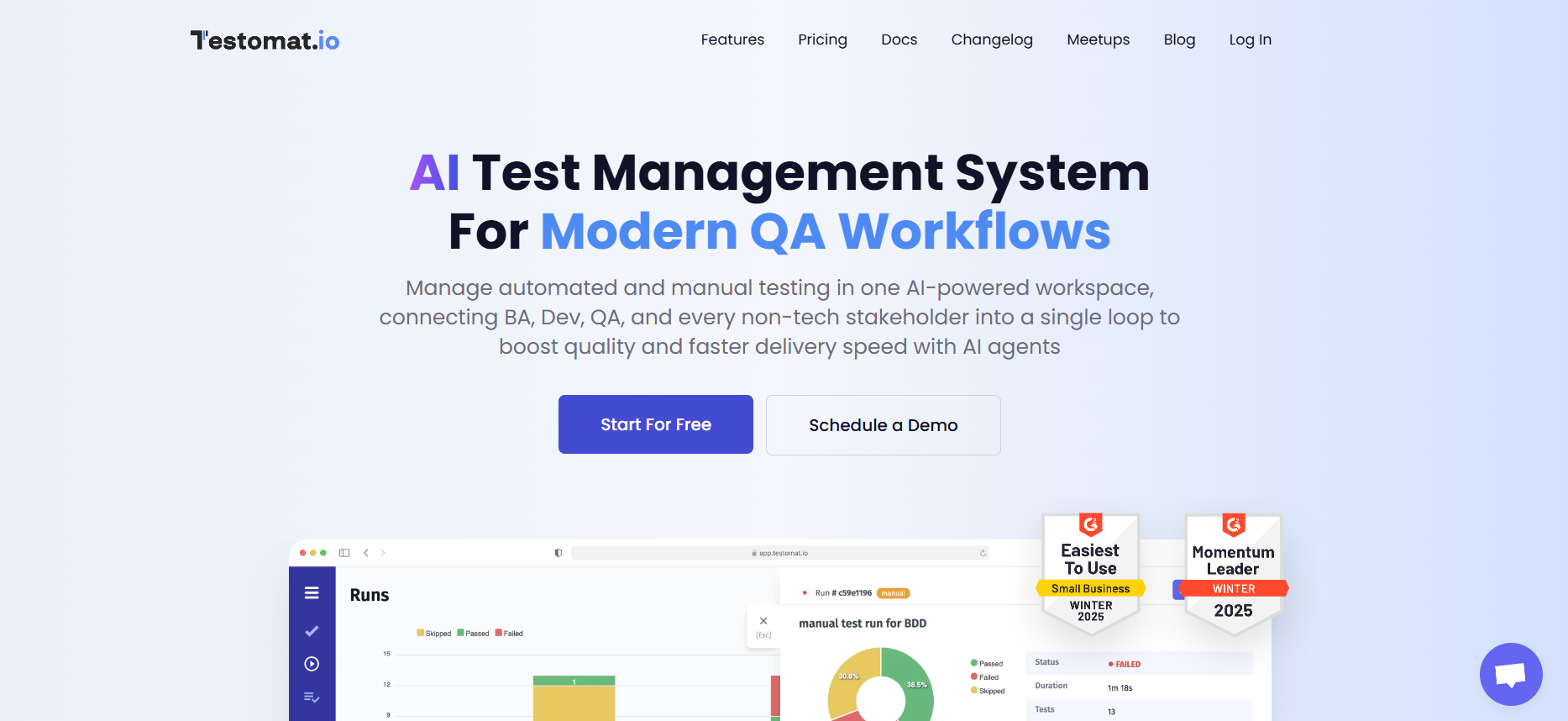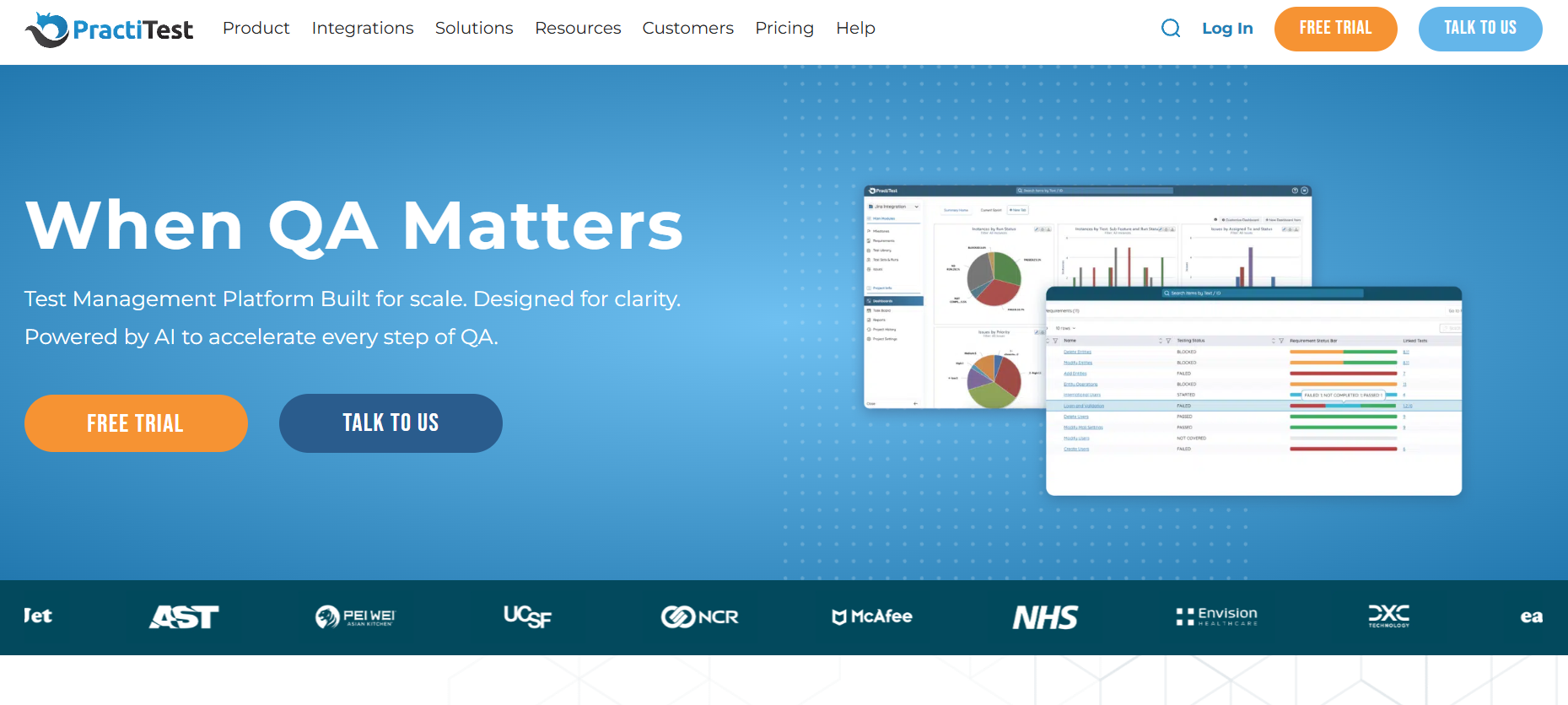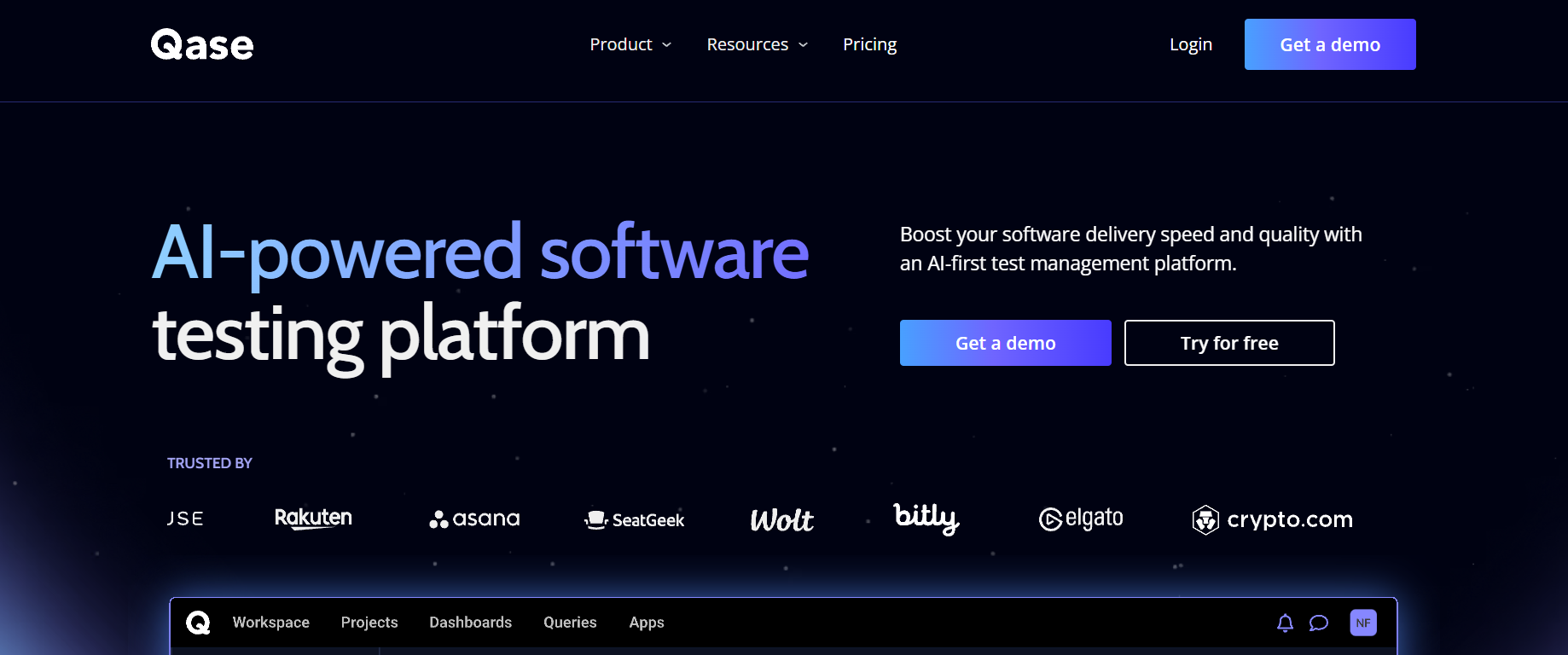Heads up, folks—shipping code at warp-speed is awesome until your QA board looks like confetti and the pipeline crawls slower than dial-up. If your reports live in twelve places and CI/CD still drinks coffee before turning green, it’s time for something bolder. This playbook dives straight into test management with playwright api testing, fusing killer browser runs with slick api test management so you see every spike, status code, and flaky call in one hub.
We’ll tap the muscle of playwright api testing plus the heat-map brains of Testomat.io to unlock end-to-end Playwright tracking that actually makes sense. No more guess-work, no more lost logs—just snapshot-clean dashboards, unified HTML report streams, and releases that cruise instead of stall. Strap in, because your test suites are about to run like jet fuel.
Quick-Scan Comparison Table
| Tool | Best for | Playwright test reporting | CI/CD hook | Price from* |
|---|---|---|---|---|
| Testomat.io | All-in qa dashboards Playwright API & unified oversight | Native HTML + JSON, instant heat-maps | GitHub, GitLab, Jenkins, Azure (1-liner) | Free, $30 user/mo (Pro) |
| TestRail | High-volume test suites & browser automation crews | XML upload → HTML add-on | API script / Jenkins | $39 user/mo |
| PractiTest | Cross-project insight & parallel test execution at scale | Built-in dashboards + REST pull | Webhooks, CircleCI | $54 user/mo |
| Qase | Lean teams chasing fast regression loops | JSON dump → HTML snapshot | GitHub Actions plug-in | Free, $30 user/mo (Startup) |
| Testmo | Dev-heavy squads wanting one repo for code + cases | CLI upload → unified trend charts | Any pipeline via CLI | $99 user/mo |
*Public list prices — vendors run promos, so check sites for deals.
1. Testomat.io
 Built for velocity, Testomat.io snaps your Playwright test suites, API calls, and UI flows into a single html report stream. Live status code badges flip red or green, and a smart browser context switcher proves the same run across different browsers. With first-class playwright test reporting and slick playwright results integration, you finally get one board for every build, branch, and micro-service.
Built for velocity, Testomat.io snaps your Playwright test suites, API calls, and UI flows into a single html report stream. Live status code badges flip red or green, and a smart browser context switcher proves the same run across different browsers. With first-class playwright test reporting and slick playwright results integration, you finally get one board for every build, branch, and micro-service.
Key Features of Testomat.io
- Unified UI + API dashboard with heat-maps
- Auto-merge of Playwright and REST results per test execution
- Real-time defect tracking & slack pings
- One-click flaky-test quarantine for rock-solid test reliability
- Multi-project test suites import (Jest, Mocha, Cypress)
- Visual diff & baseline snapshots for browser automation checks
- Native Jira/GitHub actions for CI/CD Playwright automation
Pros of Testomat.io
- Zero-setup cloud, spins up in minutes
- Unlimited projects on the free tier
- Super-clean HTML report you can mail to execs
- Fine-grained roles for QA vs dev squads
- Instant rerun of a single test run straight from the UI
- Deep API that lets you script anything
- Nightly parallel test execution without extra config
Cons of Testomat.io
- On-prem install still in private beta
- Advanced analytics locked behind Pro
Pricing of Testomat.io
Free / $30 Pro per user / mo
2. TestRail
 TestRail is the legacy king that many enterprises still lean on. Plug in Playwright via API and your html report data flows straight into its time-tested grid. It handles massive test suites, logs every status code, and works nicely with classic Jenkins pipelines—though UI feels a bit old-school.
TestRail is the legacy king that many enterprises still lean on. Plug in Playwright via API and your html report data flows straight into its time-tested grid. It handles massive test suites, logs every status code, and works nicely with classic Jenkins pipelines—though UI feels a bit old-school.
Key Features of TestRail
- Bulk case management with foldered test suites
- API push for Playwright test reporting
- Custom fields for browser automation labels
- Trend charts tracking pass/fail over time
- Scheduled PDF exports for stakeholders
Pros of TestRail
- Mature permission model
- Handles millions of cases without choking
- Strong audit trail for regulated teams
- CI hooks for Jenkins, TeamCity, Bamboo
- Decent REST API for custom scripts
Cons of TestRail
- Outdated UI/UX
- Playwright integration needs manual API scripting
- Per-seat cost can balloon for large squads
Pricing of TestRail
$39 per user / mo (cloud)
3. PractiTest
 PractiTest gives you cross-project visibility and drill-downs that tie test execution to user stories. Playwright results show up beside manual checks, letting you compare UI clicks and API status code failures under one roof. Handy if you juggle web and mobile in different browsers daily.
PractiTest gives you cross-project visibility and drill-downs that tie test execution to user stories. Playwright results show up beside manual checks, letting you compare UI clicks and API status code failures under one roof. Handy if you juggle web and mobile in different browsers daily.
Key Features of PractiTest
- Unified dashboard for manual + automated runs
- Native REST pull for Playwright results integration
- Cross-project analytics & risk matrix
- Customizable html report widgets
- Built-in defect life-cycle with Jira sync
Pros of PractiTest
- Polished, modern interface
- Crystal-clear risk graphs for managers
- Smart filters for flaky vs solid tests
- SOC 2 compliant hosting
- Live Jira / Slack feed on failures
Cons of PractiTest
- No on-prem option
- API rate limits on lower tiers
- Pricey for small startups
Pricing of PractiTest
$99 per user / mo
4. Qase
 Qase keeps things lean for growth teams. A GitHub Action pumps Playwright test suites and browser context combos into a minimalist board that still spits out a neat html report. Light enough for side projects, but strong on tags and test execution timelines.
Qase keeps things lean for growth teams. A GitHub Action pumps Playwright test suites and browser context combos into a minimalist board that still spits out a neat html report. Light enough for side projects, but strong on tags and test execution timelines.
Key Features of Qase
- One-click GitHub / GitLab integration
- JSON → HTML auto-reporter
- Tag-based case organization for different browsers
- Real-time run logs with status code markers
- REST API for custom tooling
Pros of Qase
- Fast onboarding—10 min and you’re set
- Clean, distraction-free interface
- Free public project tier for OSS
- Easy bulk import from CSV or XML
- Slack & Teams webhooks included
Cons of Qase
- No on-prem edition
- Limited analytics vs bigger suites
- Parallel test execution needs higher tier
Pricing of Qase
Free, $30 per user / mo
5. Testmo
 Testmo speaks developers’ language – CLI first, UI second. Push Playwright runs from any pipeline and watch browser automation stats roll into Markdown-friendly dashboards. If you love code-centric qa automation software playwright workflows, this one vibes.
Testmo speaks developers’ language – CLI first, UI second. Push Playwright runs from any pipeline and watch browser automation stats roll into Markdown-friendly dashboards. If you love code-centric qa automation software playwright workflows, this one vibes.
Key Features of Testmo
- Command-line uploader for any Playwright project directory
- Time-series charts of pass/fail & duration
- Markdown-rich comments in each test file
- REST API & webhooks for limitless hacks
- Native Git repository links for source dive
Pros of Testmo
- Dev-centric CLI fits any stack
- Unlimited pipelines; you pay per seat, not per run
- Custom SQL-like queries for flaky-test hunting
- Clean dark-mode dashboard
- Supports mixed UI & API runs side-by-side
Cons of Testmo
- Steep learning curve for non-tech QA
- No visual comparison tools built-in
- Highest seat price in this lineup
Pricing of Testmo
$99 per user / mo
How to Choose the Right Playwright Stack in 2025
- Integration depth. Your tool should slide into CI like butter—one tweak in the
configuration file, shove the run, boom. Look for zero-config test run uploads and native Playwright results integration so you’re not welding custom scripts every sprint. - Reporting clarity. Execs want answers, not CSVs. Grab a platform that spits a glossy HTML report with live status-code chips and links back to the exact test logic that failed. If they can’t spot red in two clicks, keep shopping.
- Parallel test execution. Launching suites across multiple browser versions (and even different browsers) is non-negotiable. Make sure the stack handles parallel jobs without ghosting flaky metrics—else your release train brakes.
- Best practices baked in. Vendors worth their salt ship sample CRUD flows, opinionated best practices, and docs that track the latest version of Playwright so you’re never patch-hunting at midnight.
- Team skill level. Got click-happy juniors and CLI-loving seniors? You need UI simplicity plus deep hooks. A tool that lets newbies point-and-shoot while vets tweak YAML is the sweet spot.
Bottom line: Which Test Management Tool is Better?
One last nudge: every hour your team spends babysitting scattered reports is an hour the competition ships. Spin up a free Testomat.io workspace, plug in your Playwright project directory, and watch those qa dashboards sing. From the very first single test run you’ll notice the shift—status codes pop, flaky flows flash, and managers finally get the whole story in one scroll. Ditch the Franken-scripts and grab a powerful tool that doubles as a full-strength playwright testing platform solution.
FAQ
Is Playwright Suitable for API testing?
Absolutely. Playwright ships a built-in request context that fires GET, POST, PUT, DELETE on any endpoint, captures response body and status code, and runs inside the same test suites as your UI checks. Pair it with Testomat.io for api test management and unified html report dashboards.
How to Get API Response in Playwright?
Use Playwright’s APIRequestContext. Create a request context in your configuration file, call request.get() or post(), then read response.status() and response.json() for the payload. The data appears in the playwright test reporting flow, so every single test run logs the raw API response.
How to Write a Test Plan for API testing?
Start with scope: list endpoints, success criteria, and test data. Map CRUD coverage—GET request, POST request, PUT request, DELETE request—then assign priority, browser context if UI hits follow, and expected status code. Finally, define reporting needs: html report format, slack alerts, and parallel test execution cadence.
How do You Test API testing?
Automated API testing loops through three phases: build test scripts, execute, and analyze. Use a test automation framework like Playwright, load test data from fixtures, hit the api endpoint, assert status code and response body, then push results into qa dashboards Playwright API for reliability insights.
How to Perform Playwright API testing?
Kick off with a new Playwright project directory, import APIRequestContext, and script your calls in api.spec.ts. Chain get request, post request, or put request, verify status code, and stash the response body. Schedule runs in CI; Testomat.io merges each single test run into one powerful html report stream.